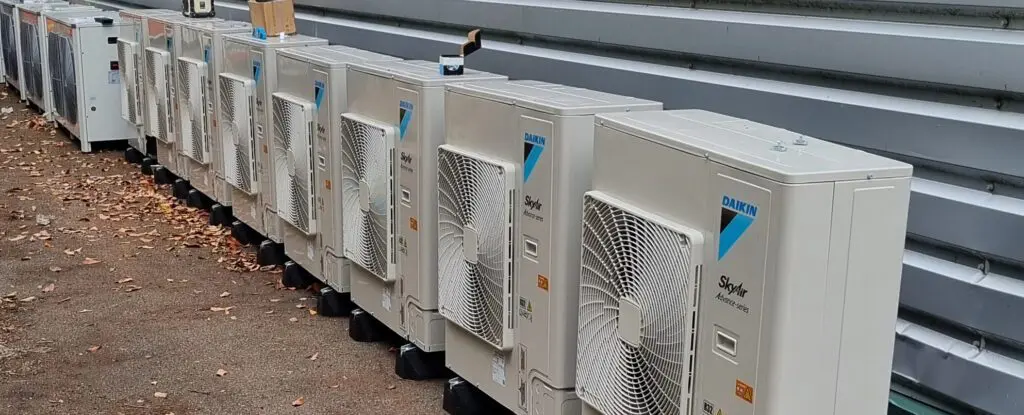Walk-in fridges and freezers are an essential component for many businesses, and as a modern society, we couldn’t be without them! Whether you run a restaurant, florists, or garden centre – cold room solutions like walk-in fridges and freezers help us to store and preserve our products for longer for our customers.
But, what actually makes a cold room cold? The refrigeration cycle.
The refrigeration cycle is complex so the experts at MTCSS have de-bunked what is meant by the refrigeration cycle and how it keeps your stock chilled. Read on to find out more…
What Parts are Involved in the Refrigeration Cycle?
To understand the refrigeration cycle fully, we first need to understand the parts that are involved.
The refrigeration cycle is only possible because of the culmination of 4 parts, which are found in every fridge and freezer (commercial or non-commercial), including:
Compressor
Acting as the ‘heart’ of a fridge/freezer, the compressor circulates the refrigerant gas through the system and adds pressure to the warm part of the circuit to make the refrigerant hot.
It is found at the back and bottom of your fridge.
Condenser
The condenser removes heat from the refrigerant. It cools and condenses the refrigerant gas coming from the compressor into a vapour and then a liquid.
It is found either under the fridge, on the back of the fridge, or the top of the fridge (model dependant).
Expansion Valve
This valve controls the flow of liquid refrigerant being pumped from the condenser to the evaporator, situated between the condenser and the inlet of the evaporator.
Evaporator
The evaporator is the part that makes your fridge cold and is located on the bottom or back of your fridge in coils.
Now that we understand the different elements that are part of the cycle, let’s see how they aid the completion of the refrigeration cycle and keep our stock cold.

The Complete Refrigeration Cycle
Walk-in fridges and walk-in freezers remain consistently cold all day, every day, due to the help of refrigeration systems.
The refrigeration cycle goes through four main stages: compression, condensation, expansion, and evaporation.
Each stage of the cycle reflects the main components – the compressor, condenser, expansion valve and the evaporator. Below are the steps of the refrigeration cycle:
1) Compressor
The refrigeration cycle begins and ends with the compressor.
It sucks the heated refrigerant gas through a suction pipe and begins to compress it, hence the name, compressor. After this, the pressure, temperature, and energy of the compressed refrigerant gas increases whilst the volume decreases.
The compression stage ends when the temperature and energy of the refrigerant are high and it is classified as a ‘hot gas’.
2) Condenser
Once the refrigerant is hot, the hot gas is then pushed into the condenser, where it turns the gas vapour into a liquid.
At this point, the condenser takes some of the heat by absorbing it and cooling it down with either air or water, depending on the model. This turns the refrigerant into a hot liquid.
3) Expansion Valve
Now the refrigerant is a hot liquid, it enters the expansion valve where it expands, loses pressure, and loses heat.
The hot liquid cools when in the expansion valve because of a pressure decrease – leaving the expansion valve as a cold and slow liquid refrigerant.
4) Evaporator
After the expansion valve has cooled and slowed the liquid refrigerant, it enters the evaporator.
Here, the exchange of heat takes place – cooling the equipment inside the fridge, while the liquid refrigerant vaporises back into a gas.
In this process, the refrigerant then takes heat away from the fridge’s contents, to chill them, and absorbs it, therefore turning it back into a gas.
The gas is then pushed back into the compressor where the closed-loop cycle will begin again.
Benefits of Understanding the Refrigeration Cycle
Now we know what it is, how does it benefit us to know about the refrigeration cycle?
The main benefits of understanding the refrigeration cycle include:
- Understanding how to clean and maintain cold room equipment effectively – Knowing the key elements of a refrigeration system should allow you to keep them well maintained and easily replace them where necessary.
- Finding the ideal position for your refrigeration system – Your refrigeration system must have ample space to be able to reliably refrigerate your products, so understanding where the elements of your should sit will allow you to find the ideal position for them.
This also helps your cold room complete the refrigeration system more easily and lowers your overall energy consumption. - To fix issues if things go wrong – If you have an understanding of the refrigeration system and the different stages, then you are prepared if they break down.
This knowledge means you should be able to assess what went wrong by identifying the stage your refrigeration system was at – allowing you to explain to an engineer what you believe the fault in your cold room is.
For help with maintaining your cold room and refrigeration systems, or to ask any questions about the refrigeration cycle, reach out to our team today by calling 01886 833 381, emailing us at sales@mtcss.co.uk, or by filling in the enquiry form below – we’ll be in touch as soon as possible.


